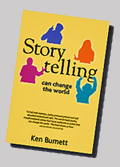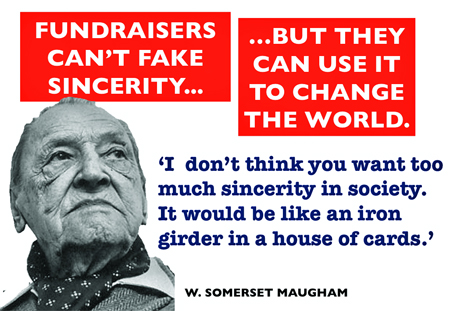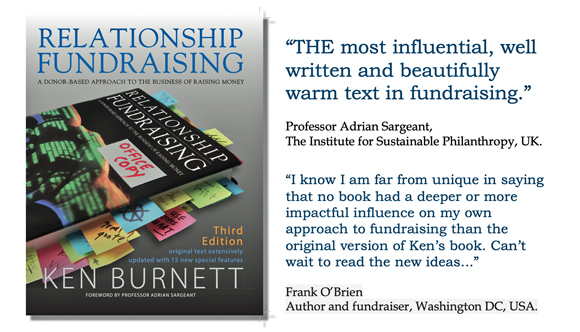| |
 Opinion Opinion
From Ken Burnett, writer, publisher,
motivational speaker and occasional fundraising consultant.
Blog 28th June 2016.
Continuing an occasional series featuring issues
of interest to
the Commission
on the Donor Experience.
We must stop, right now, many of the practices that fundraisers routinely use today to extract increased donations.
Thirty years ago Botton Village developed an early forerunner of FPS. Yet they’ve never tested it. Here’s why they never will.
It goes without saying that fundraisers also need to rethink recruitment, so they put the right people in place.
 Storytelling can change the World Storytelling can change the World
is reviewed here and here and you can buy it here.
|
It’s simplistic, I know, but I do like conflicts to be clear cut. Goodies and baddies. No shades of grey. No in-between. Right is right and the rest is wrong. So in this debate I quickly take a side.
The question is, are fundraisers ethical, dedicated to doing the right thing by donors? Or are they merely hard-sell sales people who must do whatever it takes to reach their ever-higher targets?
To some it might seem a question not worth asking. Of course, given the nature of whom they ask and what they ask for, fundraisers must be guided by the highest moral ethical standards and considerations.
But if that’s so, why do fundraisers follow so much bad practice that’s simply bound to antagonise donors? And probably won’t raise much money anyway?
In mid 2016, a year after the Olive Cooke story broke and 24 years since I first proposed the concept of relationship fundraising, the sad truth is that much routine fundraising practice remains abhorrent to the public, deeply mistrusted, even despised. Yet it brings results, of a sort, so some persist in promoting and perpetuating it. It doesn’t take much to see this must change.
Don’t get me wrong. I’m not saying we shouldn’t vigorously pursue our trade, telling our stories with enthusiasm, skill, power and passion that will move people to action. But we must, right now, stop many of the practices that fundraisers routinely use today to extract increased donations and focus instead on different ways that always do the right thing by donors.
Unacceptable behaviours
that should change now
• No means no. Fundraising is inevitably intrusive and often unwelcome. Fundraisers should seek out the signs that tell them their approach isn’t appreciated and not hesitate to take no for an answer, instantly, politely and respectfully.
• Giving is always voluntary. Passion, emotion, enthusiasm by all means, but no more persuasion. Before they can be recruited donors first have to be effectively engaged and inspired. No more pushy, aggressive persistence.
• No more thoughtless, bad or inappropriate language when talking about donors as well as to them.
• Donors have a right to control what they receive. Fundraisers should now be offering donors choices, so they can take charge of how, what about and when they hear from fundraisers.
• Fundraisers need to be especially sensitive, respectful and skilful in how they encourage and inspire legacies. No hint of aggressive marketing should reach donors.
• Formulaic approaches that take no account of the individual should be avoided. Conventions that require fundraisers to ask at least three times in a three-minute call or 14 times on the first page of a fundraising letter should be dropped. No more imagining that as long as your next mailing generates more money than it costs, you can mail more. Fundraisers need to take account of non-responders, as much as those who give. No more believing that the way to raise more money is to ask more people for more cash more often and more vigorously.
• Test and innovate, of course, but don’t test anything that your donors might find unacceptable, or that might diminish the quality of their experience. Fundraising leaders must be particularly alert to spotting changes in an accepted acquisition paradigm, when it moves from being interesting and engaging to formulaic, tired and repetitive.
• Measure differently what fundraisers do. Learn to track and measure commitment, satisfaction, loyalty and future intentions as well as money in now.
• No more putting donations ahead of donors. No more asking for extra monthly gifts without mentioning that the donor already has a monthly direct debit. No more reverse tick boxes, or similar techniques of gift-leading. No more asking donors to give to a new campaign without acknowledging he or she already gives to another campaign. With shopping lists, make it clear that it’s the donor who decides, all gifts are welcome, all make a difference. If a donor has set up multiple direct debits, check that’s what he or she wants and offer the option to rationalise.
• No more donors giving in spite of fundraisers rather than because of them.
• No more charity creative messaging that makes non-donors feel bad, rather than makes donors feel good.
• No more slow and inadequate feedback on the differences donors make.
The above is a partial list only. Each activity recommended for change is commonly practiced in British fundraising today.
It goes without saying that fundraisers also need to rethink recruitment, so they put the right people in place. And that those new to the profession must be steeped in the basic fundamentals of their craft. I'll save further comment on this for a future article.
Continued top of column 2, above.
|

Perhaps if sincerity ran through fundraising practices like an iron girder our sector would have been less vulnerable to media assaults.
Continued from column 1, below.
There should be no further need to remind fundraisers of the unacceptability of any behaviour that might upset a donor or seem inappropriate to him, or her. Yet while planning for change, it’s crucial to make three caveats:
1. Our sector cannot accept reduced income.
If we allow donated income to fall and our voluntary sector shrinks as a result we will fail our causes, our staff, our donors and our beneficiaries.
2. It is not our job to make people comfortable. Comfortable people, generally, do nothing. Our job instead is to respectfully alert them to and effectively engage them in issues that concern them, showing them the practical, stress-free and fulfilling action they can take, as a donor, that will make a significant difference.
3. Fundraisers must get better at inspiring people.
As Bluefrog’s Mark Phillips pointed out in a recent blog, ‘The introduction of paperless direct debits combined with the massive commercialisation of face-to-face fundraising…allowed charities to sign up regular givers without going through the process of engaging them first.’ So we need to get better at inspiring and engaging, while we reduce our persistence and persuasion.
Thirty years ago the Yorkshire-based charity Botton Village developed an early forerunner of the Fundraising Preference Service. Yet they’ve never tested it. Here’s why they never will.
All fundraisers should be aware of the Botton Village story, perhaps the greatest fundraising case history of our time. See here and here.
Botton’s fundraisers believed that giving donors choices was the right thing to do. Had anyone proposed they should test it, they would have said, ‘If something is right for our donors, if it’s the right thing to do, why would we want to test it – to give some donors the wrong thing? Just to see if there’s another way we could raise a bit more money is not a good enough answer.’
Our sector needs to accept this, and change, so at all times fundraisers do what’s right for donors and not just what generates the most cash.
Involvement devices vs gimmicks
Other issues abound. Are premiums, raffles and prize draws compatible with the image we want donors to have of charities, so fair game for fundraisers? There are many more, for sure. All now need to be re-assessed and, where necessary, changed.
What should matter most to fundraisers now is that we all work energetically together on a new view of charities and fundraising for all our publics. One that consistently shows respect and fairness for donors and a commitment to doing the right thing by them, not just what raises the most money.
© Ken Burnett 2016
Related earlier articles:
• Evolving into the inspiration business.
• Asking properly, the only sustainable way to do fundraising.
• The future of targets.

Please note: though Ken Burnett was joint initiator of the Commission on the Donor Experience (with Giles Pegram CBE) and is fully committed to helping it to achieve its goals, the views in these blogs are his own.

Home page | Current blogs | Article archive
|
 Storytelling can change the World
Storytelling can change the World 


